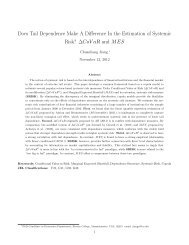Chapter 18. Introduction to Four Dimensions Linear algebra in four ...
Chapter 18. Introduction to Four Dimensions Linear algebra in four ...
Chapter 18. Introduction to Four Dimensions Linear algebra in four ...
You also want an ePaper? Increase the reach of your titles
YUMPU automatically turns print PDFs into web optimized ePapers that Google loves.
�<br />
5<br />
has nonzero 2-m<strong>in</strong>ors, for example det<br />
13<br />
3-m<strong>in</strong>ors are zero. For example,<br />
�<br />
7<br />
= −16. But all sixteen of the<br />
15<br />
⎡<br />
0 2<br />
⎤<br />
3<br />
det ⎣ 4 6 7 ⎦ = 0.<br />
12 14 15<br />
Therefore rank(A) = 2 and dim ker(A) = 4 − 2 = 2. In other words, the <strong>four</strong><br />
row hyperplanes of A <strong>in</strong>tersect not <strong>in</strong> the usual po<strong>in</strong>t, but <strong>in</strong> a plane. Moreover,<br />
the plane ker A is the <strong>in</strong>tersection of any two row hyperplanes of A.<br />
To m<strong>in</strong>imize the calculation of determ<strong>in</strong>ants, you can sometimes use row reduction<br />
<strong>to</strong> simplify a matrix before try<strong>in</strong>g <strong>to</strong> f<strong>in</strong>d its rank and kernel, as follows.<br />
Suppose u and v are two rows of A. Take any nonzero scalars a, b and replace<br />
row u by au + bv, giv<strong>in</strong>g a new matrix A ′ which differs from A only <strong>in</strong> the row<br />
that was u and is now au + bv. Then we have<br />
rank(A) = rank(A ′ ), ker(A) = ker(A ′ ).<br />
In the example above, we replace each of rows 2, 3, 4 by itself m<strong>in</strong>us the row<br />
immediately above, and get<br />
A ′ ⎡<br />
0<br />
⎢<br />
= ⎢4<br />
⎣4<br />
1<br />
4<br />
4<br />
2<br />
4<br />
4<br />
⎤<br />
3<br />
4 ⎥<br />
4⎦<br />
4 4 4 4<br />
.<br />
This shows that ker(A) is the <strong>in</strong>tersection of the two hyperplanes<br />
The <strong>in</strong>verse of a 4 × 4 matrix<br />
y + 2z + 3w = 0, x + y + z + w = 0.<br />
Given a 4 × 4 matrix A, let Aij be the 3 × 3 matrix obta<strong>in</strong>ed by delet<strong>in</strong>g row<br />
i and column j from A. Form the matrix [(−1) i+j det(Aij] whose entry <strong>in</strong> row i<br />
column j is (−1) i+j det(Aij). Now take the transpose of this matrix and divide<br />
by det(A), and you will get the <strong>in</strong>verse of A:<br />
A −1 = 1<br />
det A [(−1)i+j det(Aij)] T .<br />
6

















